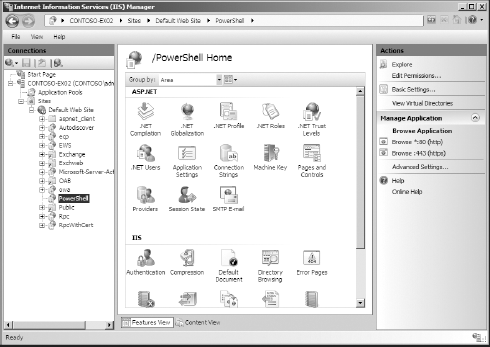4. Remote PowerShell
One of the new features of Exchange Server 2010 is
the ability to remotely connect to the Exchange Management Shell (EMS)
and issue commands from another computer. This is made possible by the
PowerShell virtual directory. The PowerShell virtual directory is
installed on every role by default except for the Edge Transport
server. In fact, when you open the EMS locally on an Exchange server,
it connects to the PowerShell virtual directory that is running on the
server itself. As you can see in Figure 1,
the PowerShell virtual directory shows up in the Internet Information
Services (IIS) Manager as a web service, just like the other Exchange
virtual directories. You can view the properties of the PowerShell
virtual directory using IIS Manager, though Microsoft recommends using
the EMS cmdlets to view and make changes to the PowerShell virtual
directory when possible.

As with other virtual directories in Exchange, the
EMS provides a set of cmdlets that can be used for configuring the web
service. Exchange includes the following cmdlets for PowerShell:
Get-PowerShellVirtualDirectory
Set-PowerShellVirtualDirectory
New-PowerShellVirtualDirectory
Remove-PowerShellVirtualDirectory
Test-PowerShellConnectivity
Exchange gives you the Test-PowerShellConnectivity
cmdlet that you can use to test the connection to the PowerShell
virtual directory. You can specify various options with this cmdlet to
test things such as the authentication method, the certificate, and the
URL of the web service. This following example command will test the
PowerShell connection using Basic authentication and ignoring
certificate problems:
Test-PowerShellConnectivity -TrustAnySSLCertificate
-ConnectionUri https://mail.pacific.contoso.com -Authentication Basic
CasServer LocalSite Scenario Result Latency(MS) Error
--------- --------- -------- ------ ----------- -----
Honolulu Logon User Success 890.45
As you can see from the output, the test
provides some useful information, such as the success of the connection
and even the latency encountered.
5. Outlook Web App
Outlook Web App (OWA) underwent several changes in
Exchange Server 2010. The first and most obvious is the name change
from Outlook Web Access to Outlook Web App. In addition, there have
been many other graphical user interface (GUI) changes. Here are some
of the more obvious ones:
Overall theme change
Conversation view on messages
OWA options that use the Exchange Control Panel
Instant Messaging integration through Office Communications Server
There are some great administrative changes
in OWA as well. Probably the biggest is the ability to apply a mailbox
policy specifically for OWA. You can create and manage Outlook Web App
mailbox policies through the Organization Configuration =>
Client Access node in the EMC. Inside the OWA mailbox policy, you will
find the segmentation options such as enabling and disabling certain
items and functionality. After you create or edit an OWA mailbox
policy, you can apply the policy to one or more users.